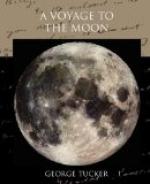It is somewhat remarkable, that perhaps the only “Voyages to the Moon,” which have been published in the English tongue, should have been the productions of English bishops:—the first forming a tract, re-published in the Harleian Miscellany, and said to have been written by Dr. Francis Goodwin, Bishop of Landaff, (who died in 1633,) and entitled “The Man in the Moon, or the discourse of a voyage thither, by Domingo Gonsales,”—and the second written in 1638, by Dr. John Wilkins, Bishop of Chester, under the title of “The Discovery of a New World, or a Discourse tending to prove, that ’tis probable there may be another habitable world in the Moon, with a discourse concerning the possibility of a passage thither." These two works differ in several essential particulars:—in Dr. Goodwin’s, we have men of enormous stature and prodigious longevity, with a flying chariot, and some other slight points of resemblance to the Travels of Gulliver:—whilst Bishop Wilkins’s is intended honestly and scientifically to prove, “that it is possible for some of our posterity to find out a conveyance to this other world; and, if there be inhabitants there, (which the Bishop, satisfactorily to himself, settles,) to have commerce with them!” From the first of these, Swift has derived many hints in his voyage to Laputa, and improved them into those humorous and instructive allusions, which have caused the reputation of the author of the "Travels of Gulliver" to be extended to every portion of the civilized globe. Since the appearance of this celebrated satire, no one sufficiently comprehensive to lash the follies of the age—the quicquid agunt homines—has made its appearance: we have had numerous ephemeral productions, inflicting severe castigations upon particular vices or absurdities; but the visionary conceits of the many, constantly promulgated in the progressive advancement of human knowledge, although legitimate objects of censure, have not, since the time of Swift, been embodied into one publication.
The evident aim of the author of the Satirical Romance before us, is to fulfil for the present age, what Swift so successfully accomplished for that which has passed by:—to attack, by the weapons of ridicule, those votaries of knowledge, who may have sought to avail themselves of the universal love of novelty amongst mankind, to acquire celebrity; or who may have been misled by their own ill-regulated imaginations, to obtrude upon the world their crude and imperfect theories and systems, to the manifest retardation of knowledge:—an effect, too, liable to be induced in a direct ratio with the degree of talent and ingenuity by which their views may have been supported. Several of these may always be more successfully attacked by ridicule than by reason; inasmuch as they are, in this way, more likely to become the subjects of popular animadversion; and many, who could withstand the serious arguments of their fraternity, cannot placidly endure their ridicule. Satire has, indeed, often done more service to the cause of religion and morality than a sermon, since the remedy is agreeable, whilst it at the same time communicates indignation or fear:—




